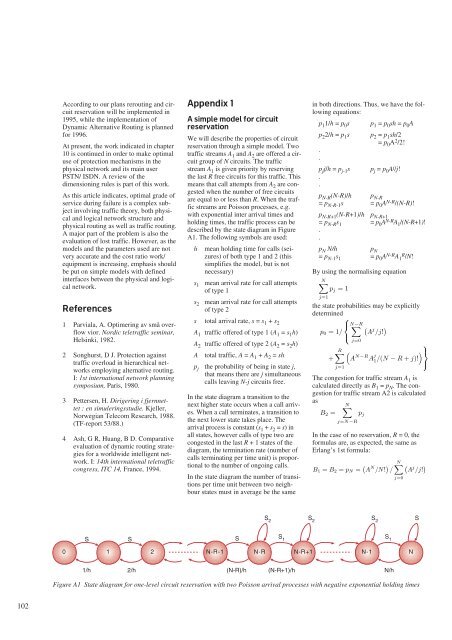Contents Telektronikk - Telenor
Contents Telektronikk - Telenor
Contents Telektronikk - Telenor
Create successful ePaper yourself
Turn your PDF publications into a flip-book with our unique Google optimized e-Paper software.
102<br />
According to our plans rerouting and circuit<br />
reservation will be implemented in<br />
1995, while the implementation of<br />
Dynamic Alternative Routing is planned<br />
for 1996.<br />
At present, the work indicated in chapter<br />
10 is continued in order to make optimal<br />
use of protection mechanisms in the<br />
physical network and its main user<br />
PSTN/ ISDN. A review of the<br />
dimensioning rules is part of this work.<br />
As this article indicates, optimal grade of<br />
service during failure is a complex subject<br />
involving traffic theory, both physical<br />
and logical network structure and<br />
physical routing as well as traffic routing.<br />
A major part of the problem is also the<br />
evaluation of lost traffic. However, as the<br />
models and the parameters used are not<br />
very accurate and the cost ratio work/<br />
equipment is increasing, emphasis should<br />
be put on simple models with defined<br />
interfaces between the physical and logical<br />
network.<br />
References<br />
1 Parviala, A. Optimering av små overflow<br />
vior. Nordic teletraffic seminar,<br />
Helsinki, 1982.<br />
2 Songhurst, D J. Protection against<br />
traffic overload in hierarchical networks<br />
employing alternative routing.<br />
I: 1st international network planning<br />
symposium, Paris, 1980.<br />
3 Pettersen, H. Dirigering i fjernnettet<br />
: en simuleringsstudie. Kjeller,<br />
Norwegian Telecom Research, 1988.<br />
(TF-report 53/88.)<br />
4 Ash, G R, Huang, B D. Comparative<br />
evaluation of dynamic routing strategies<br />
for a worldwide intelligent network.<br />
I: 14th international teletraffic<br />
congress, ITC 14, France, 1994.<br />
S<br />
S<br />
Appendix 1<br />
A simple model for circuit<br />
reservation<br />
We will describe the properties of circuit<br />
reservation through a simple model. Two<br />
traffic streams A1 and A2 are offered a circuit<br />
group of N circuits. The traffic<br />
stream A1 is given priority by reserving<br />
the last R free circuits for this traffic. This<br />
means that call attempts from A2 are congested<br />
when the number of free circuits<br />
are equal to or less than R. When the traffic<br />
streams are Poisson processes, e.g.<br />
with exponential inter arrival times and<br />
holding times, the traffic process can be<br />
described by the state diagram in Figure<br />
A1. The following symbols are used:<br />
h mean holding time for calls (seizures)<br />
of both type 1 and 2 (this<br />
simplifies the model, but is not<br />
necessary)<br />
s1 mean arrival rate for call attempts<br />
of type 1<br />
s2 mean arrival rate for call attempts<br />
of type 2<br />
s total arrival rate, s = s1 + s2 A1 traffic offered of type 1 (A1 = s1h) A2 traffic offered of type 2 (A2 = s2h) A total traffic, A = A1 + A2 = sh<br />
pj the probability of being in state j,<br />
that means there are j simultaneous<br />
calls leaving N-j circuits free.<br />
In the state diagram a transition to the<br />
next higher state occurs when a call arrives.<br />
When a call terminates, a transition to<br />
the next lower state takes place. The<br />
arrival process is constant (s1 + s2 = s)in<br />
all states, however calls of type two are<br />
congested in the last R + 1 states of the<br />
diagram, the termination rate (number of<br />
calls terminating per time unit) is proportional<br />
to the number of ongoing calls.<br />
In the state diagram the number of transitions<br />
per time unit between two neighbour<br />
states must in average be the same<br />
S<br />
S 2 S 2 S 2 S<br />
0 1 2 N-R-1 N-R N-R+1 N-1 N<br />
1/h 2/h (N-R)/h (N-R+1)/h N/h<br />
Figure A1 State diagram for one-level circuit reservation with two Poisson arrival processes with negative exponential holding times<br />
S 1<br />
in both directions. Thus, we have the following<br />
equations:<br />
p11/h = p0s p1 = p0sh = p0A p22/h = p1s p2 = p1sh/2 = p0A2 /2!<br />
.<br />
.<br />
pjj/h = pj-1s pj = p0Aj /j!<br />
.<br />
.<br />
pN-R (N-R)/h pN-R = pN-R-1s = p0AN-R /(N-R)!<br />
pN-R+1 (N-R+1)/h pN-R+1 = pN-Rs1 = p0AN-RA1 /(N-R+1)!<br />
.<br />
.<br />
pN N/h pN = pN-1s1 = p0AN-RA R<br />
1 /N!<br />
By using the normalising equation<br />
N�<br />
j=1<br />
pj =1<br />
the state probabilities may be explicitly<br />
determined<br />
⎧<br />
⎨N−R<br />
� � � j<br />
p0 =1/ A /j!<br />
⎩<br />
+<br />
j=1<br />
j=0<br />
R� �<br />
A N−R A j<br />
�<br />
1 /(N − R + j)!<br />
⎫ ⎬<br />
⎭<br />
The congestion for traffic stream A1 is<br />
calculated directly as B1 = pN . The congestion<br />
for traffic stream A2 is calculated<br />
as<br />
N�<br />
B2 =<br />
j=N−R<br />
pj<br />
In the case of no reservation, R = 0, the<br />
formulas are, as expected, the same as<br />
Erlang’s 1st formula:<br />
B1 = B2 = pN = � A N /N ! � /<br />
S 1<br />
N� � �<br />
j<br />
A /j!<br />
j=0

















